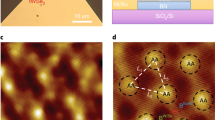Abstract
We present a general method for the electronic characterization of aperiodic 2D materials using ab-initio tight binding models. Specifically studied is the subclass of twisted, stacked heterostructures, but the formalism provided can be implemented for any 2D system without long-range interactions. This new method provides a multi-scale approach for dealing with the ab-initio calculation of electronic transport properties in stacked nanomaterials, allowing for fast and efficient simulation of multi-layered stacks in the presence of twist angles, magnetic field, and defects. We calculate the electronic density of states in twisted bilayer systems of graphene and MX\(_2\) transition metal dichalcogenides (TMDCs). We comment on the interesting features of their density of states as a function of twist-angle and local configuration and how these features are experimentally observable. These results support the bilayer twist-angle as a new variable for controlling electronic properties in artificial nanomaterials (“Twistronics”).
Access this chapter
Tax calculation will be finalised at checkout
Purchases are for personal use only
Similar content being viewed by others
References
A. Ayari, E. Cobas, O. Ogundadegbe, M.S. Fuhrer, Realization and electrical characterization of ultrathin crystals of layered transition-metal dichalcogenides. J. Appl. Phys. 101(1), 014,507 (2007), https://doi.org/10.1063/1.2407388, http://scitation.aip.org/content/aip/journal/jap/101/1/10.1063/1.2407388
J. Bellissard, A. van Elst, H. Schulz-Baldes, The noncommutative geometry of the quantum Hall effect. J. Math. Phys. 35(10), 5373 (1994), https://doi.org/10.1063/1.530758, http://scitation.aip.org/content/aip/journal/jmp/35/10/10.1063/1.530758
R. Bistritzer, A.H. MacDonald, Moire bands in twisted double-layer graphene. Proc. Natl. Acad. Sci. United States of America 108(30), 12,233–7 (2011), https://doi.org/10.1073/pnas.1108174108, http://www.pubmedcentral.nih.gov/articlerender.fcgi?artid=3145708&tool=pmcentrez&rendertype=abstract
I. Brihuega, P. Mallet, H. González-Herrero, G. Trambly de Laissardière, M.M. Ugeda, L. Magaud, J.M. Gómez-Rodríguez, F. Ynduráin, J.Y. Veuillen, Unraveling the intrinsic and robust nature of van Hove singularities in twisted bilayer graphene by scanning tunneling microscopy and theoretical analysis. Phys. Rev. Lett. 109(19), 196,802 (2012), https://doi.org/10.1103/PhysRevLett.109.196802, http://www.ncbi.nlm.nih.gov/pubmed/23215414
Y. Cao, J.Y. Luo, V. Fatemi, S. Fang, J.D. Sanchez-Yamagishi, K. Watanabe, T. Taniguchi, E. Kaxiras, P. Jarillo-Herrero, Superlattice-induced insulating states and valley-protected orbits in twisted bilayer graphene. Phys. Rev. Lett. 117(11), 116,804 (2016), https://doi.org/10.1103/PhysRevLett.117.116804, http://link.aps.org/doi/10.1103/PhysRevLett.117.116804
A.H. Castro Neto, F. Guinea, N.M.R. Peres, K.S. Novoselov, A.K. Geim, The electronic properties of graphene. Rev. Mod. Phys. 81(1), 109–162 (2009), https://doi.org/10.1103/RevModPhys.81.109, http://link.aps.org/doi/10.1103/RevModPhys.81.109
H. Chen, C. Ortner, QM/MM methods for crystalline defects. Part 1: locality of the tight binding model. SIAM Multiscale Model. Simul. 14(1), 232–264 (2016), https://doi.org/10.1137/15M1022628, arXiv:1505.05541
S. Fang, E. Kaxiras, Electronic structure theory of weakly interacting bilayers. Phys. Rev. B 93(23), 235,153 (2016), https://doi.org/10.1103/PhysRevB.93.235153, http://link.aps.org/doi/10.1103/PhysRevB.93.235153
S. Fang, R. Kuate Defo, S.N. Shirodkar, S. Lieu, G.A. Tritsaris, E. Kaxiras, Ab initio tight-binding Hamiltonian for transition metal dichalcogenides. Phys. Rev. B 92(20), 205,108 (2015), https://doi.org/10.1103/PhysRevB.92.205108, http://link.aps.org/doi/10.1103/PhysRevB.92.205108
A.K. Geim, I.V. Grigorieva, Van der Waals heterostructures. Nature 499(7459), 419–425 (2013), https://doi.org/10.1038/nature12385, http://www.ncbi.nlm.nih.gov/pubmed/23887427, http://www.nature.com/doifinder/10.1038/nature12385
E. Prodan, Quantum transport in disordered systems under magnetic fields: a study based on operator algebras. Appl. Math. Res. eXpress 2, 176–265 (2012), https://doi.org/10.1093/amrx/abs017, http://amrx.oxfordjournals.org/content/early/2012/10/23/amrx.abs017.short, http://amrx.oxfordjournals.org/cgi/doi/10.1093/amrx/abs017
B. Radisavljevic, A. Radenovic, J. Brivio, V. Giacometti, A. Kis, Single-layer MoS2 transistors. Nat. Nanotech. 6(3), 147–50 (2011), https://doi.org/10.1038/nnano.2010.279, http://www.ncbi.nlm.nih.gov/pubmed/21278752
A. Rozhkov, A. Sboychakov, A. Rakhmanov, F. Nori, Electronic properties of graphene-based bilayer systems. Phys. Rep. 648, 1–104 (2016), https://doi.org/10.1016/j.physrep.2016.07.003, http://linkinghub.elsevier.com/retrieve/pii/S0370157316301612
P. San-Jose, J. González, F. Guinea, Non-Abelian gauge potentials in graphene bilayers. Phys. Rev. Lett. 108(21), 216,802 (2012), https://doi.org/10.1103/PhysRevLett.108.216802, http://journals.aps.org/prl/abstract/10.1103/PhysRevLett.108.216802, http://www.ncbi.nlm.nih.gov/pubmed/23003289
K. Uchida, S. Furuya, J.I. Iwata, A. Oshiyama, Atomic corrugation and electron localization due to Moiré patterns in twisted bilayer graphenes. Phys. Rev. B 90(15), 155,451 (2014). https://doi.org/10.1103/PhysRevB.90.155451, http://link.aps.org/doi/10.1103/PhysRevB.90.155451
A. Weisse, G. Wellein, A. Alvermann, H. Fehske, The kernel polynomial method. Rev. Mod. Phys. 78(1), 275–306 (2006), https://doi.org/10.1103/RevModPhys.78.275, http://link.aps.org/doi/10.1103/RevModPhys.78.275
D. Wong, Y. Wang, J. Jung, S. Pezzini, A.M. DaSilva, H.Z. Tsai, H.S. Jung, R. Khajeh, Y. Kim, J. Lee, S. Kahn, S. Tollabimazraehno, H. Rasool, K. Watanabe, T. Taniguchi, A. Zettl, S. Adam, A.H. MacDonald, M.E. Crommie, Local spectroscopy of moiré-induced electronic structure in gate-tunable twisted bilayer graphene. Phys. Rev. B 92(15), 155,409 (2015), https://doi.org/10.1103/PhysRevB.92.155409, http://link.aps.org/doi/10.1103/PhysRevB.92.155409
C.R. Woods, L. Britnell, A. Eckmann, R.S. Ma, J.C. Lu, H.M. Guo, X. Lin, G.L. Yu, Y. Cao, R.V. Gorbachev, A.V. Kretinin, J. Park, L.A. Ponomarenko, M.I. Katsnelson, Y.N. Gornostyrev, K. Watanabe, T. Taniguchi, C. Casiraghi, H.J. Gao, A.K. Geim, K.S. Novoselov, Commensurateincommensurate transition in graphene on hexagonal boron nitride. Nat. Phys. 10(6), 451–456 (2014), https://doi.org/10.1038/nphys2954, http://www.nature.com/nphys/journal/v10/n6/abs/nphys2954.html, http://www.nature.com/doifinder/10.1038/nphys2954
L.J. Yin, J.B. Qiao, W.J. Zuo, W.T. Li, L. He, Experimental evidence for non-Abelian gauge potentials in twisted graphene bilayers. Phys. Rev. B 92(8), 081,406 (2015), https://doi.org/10.1103/PhysRevB.92.081406, http://link.aps.org/doi/10.1103/PhysRevB.92.081406
Acknowledgements
We acknowledge S. Shirodkar for providing the Li-ion itercalated graphene calculations shown in Fig. 3c and B.I. Halperin and D. Huang for helpful discussions. The computations in this paper were run on the Odyssey cluster supported by the FAS Division of Science, Research Computing Group at Harvard University. This work was supported by the ARO MURI Award No. W911NF-14-0247. SF is supported by the STC Center for Integrated Quantum Materials, NSF Grant No. DMR-1231319.
Author information
Authors and Affiliations
Corresponding author
Editor information
Editors and Affiliations
Rights and permissions
Copyright information
© 2018 Springer International Publishing AG, part of Springer Nature
About this paper
Cite this paper
Carr, S., Massatt, D., Fang, S., Cazeaux, P., Luskin, M., Kaxiras, E. (2018). Modeling Electronic Properties of Twisted 2D Atomic Heterostructures. In: Bonilla, L., Kaxiras, E., Melnik, R. (eds) Coupled Mathematical Models for Physical and Biological Nanoscale Systems and Their Applications. BIRS-16w5069 2016. Springer Proceedings in Mathematics & Statistics, vol 232. Springer, Cham. https://doi.org/10.1007/978-3-319-76599-0_13
Download citation
DOI: https://doi.org/10.1007/978-3-319-76599-0_13
Published:
Publisher Name: Springer, Cham
Print ISBN: 978-3-319-76598-3
Online ISBN: 978-3-319-76599-0
eBook Packages: Mathematics and StatisticsMathematics and Statistics (R0)




